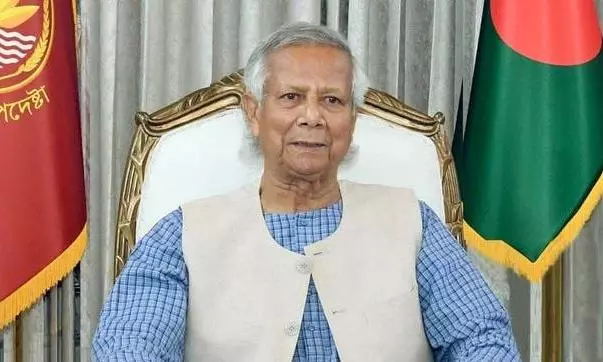In Bangladesh, the Muhammad Yunus-led interim government faces increasing pressure from trade and industry circles as well as exporters, to improve relations with India.
Sixteen months after the anti-Awami league coup organised by a violent mob of angry jobless youths and pro-Jamat Islamist organisations, the makeshift administration is still seeking much-needed stability in matters of daily governance. Unfortunately, for the pro-West, US-supported coup backers, things seem to be going from bad to worse in Bangladesh.
Except for steady remittances and export earnings, nothing seems to be going right for Bangladesh. The political situation remains as complex as ever.
Tough times in Bangladesh
Despite several announcements made by Dr Yunus, Chief Adviser of Bangladesh interim government, many people as well as political parties ranging from the BNP to small outfits, remain sceptical about the general elections taking place in February 2026.. A further confusing factor has been introduced by team Yunus to have a referendum on basic Constitutional issues on the very day of the election.
However, the general decline in the living standards of common people, the palpable rise in poverty, the never-ending erosion of the value of Bangladeshi currency 'taka' and the high inflation (the highest in South Asia!), have all combined to make Bangladesh a very hard place to live in.
From an earlier figure of around 10 per cent or so, the number of people below the poverty line is currently estimated at 39 per cent. Regarding foreign investments, there are projects in the pipeline. But in most major capitals, authorities are waiting to see the outcome of the next election, before they do further business.
Trade with India hit
Certain recent administrative steps taken by the government of India (GOI) have hit the Bangladeshi economy very hard. The Dhaka-centred mainstream media reported how a sudden decision by GOI, to 'seal' a 500 kilometre stretch of the international border it shares with Bangladesh, has just stopped all local trade and business. This was done without any prior notice given to Bangladesh.
Thousands of people engaged in the daily business of selling food, common household goods etc., were suddenly rendered jobless as the 'haats' (markets) ceased to function.
Similarly, in certain areas, all bulk deliveries of rice, wheat, eggs, vegetables and processed foods etc, meant for Bangladesh at bilaterally assigned spots were halted, again without notice.
Bangladesh trucks carrying stones, jute goods, and fish etc., into India, too, remained stalled on the roads for days on end. In short, bilateral trade both at wholesale and retail levels were affected, Indian authorities, when asked for reasons, generally said they were only complying with instructions from above following some 'complaints at the highest level'.
Bangladeshi analysts pointed out that apparently India was systematically destroying the supply system chains working between the two countries all these years following bilateral agreements.
With no explanations issued from India such moves could well be seen as India's retaliatory strikes against Bangladesh's recent decisions to step up trade and business with Pakistan, as announced by Dr Yunus in Dhaka and elsewhere.
Unexpected breakdowns
Kolkata-based wholesale traders pointed out that unexpected breakdowns in normal supply of various goods had begun from Bangladesh first. Dhaka-based rulers had suddenly cancelled an order for 1,000 tonnes of rice from India, ordering it from Pakistan instead.
Recently, it ordered the same quantity of rice from India again, which cost considerably less than rice bought from elsewhere.
Clearly, it was not India that was suddenly acting tough, they said. Bangladesh had begun importing onions from Pakistan, curtailing its earlier orders to India. But of late, Bangladesh resumed buying from India again for the same reason, the cost of buying from India was lower.
As for 'sealing'' a part of the border, it became necessary to stop/reduce illegal infiltration and smuggling from Bangladesh into West Bengal, according to BSF (South) sources.
Power deficit
But what was causing Bangladeshi authorities sleepless nights was the power situation.
A recent article in the local press pointed out that the daily shortfall in power production-cum-supply in Bangladesh was between 1,000 to 1,500 megawatts daily, depending on the seasons. Such a large deficit could be met only by large-scale imports from India. Bangladesh currently imported 15 per cent of its requirement from India.
Most planners and economists had advised Dhaka-based authorities to give up their confrontational approach towards India and develop a good working relationship. Bangladesh economy needed to acquire more power immediately, if it was keen to maintain its economic growth and progress. In fact, Bangladesh had no other option.
If its power situation, marked by daily shortages amounting to well over four-digit figures continued, for long, it would bring a financial disaster to the country. The first and worst damage would occur in the readymade garments sector production in Bangladesh, which has barely survived the present crisis.
This sector alone accounts for 80 per cent of the country's total export earnings and provides jobs for around 400,000 people. Any damage caused to this area of garments production would result in a body blow to Bangladesh's economy and its future progress.



